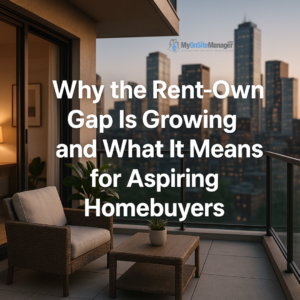The American dream of homeownership has always been a cornerstone of financial stability and personal achievement. But in 2025, that dream is becoming harder to reach than ever—at least when compared to the cost of renting.
A new report from Redfin, featured on MortgageOrb.com, reveals that the affordability gap between renting and owning a home has reached historic levels. For many would-be buyers, this growing divide is forcing tough decisions: keep renting and save longer, or stretch finances to the limit for a chance at owning.
The Numbers Behind the Gap
The latest data paints a sobering picture:
-
Annual income needed to buy a median-priced home: $116,633
-
Annual income needed to rent a median-priced apartment: $64,160
-
Difference: A staggering 81.8% gap in income requirements.
Just two years ago, the gap was significantly smaller—about 54.5%—meaning the difference between renting and owning has widened dramatically in a short time.
Why the Divide Is Growing
1. Home Prices Keep Rising
Despite a slowdown in some markets, the national median home price has climbed 4.5% year-over-year to roughly $424,000.
2. Mortgage Rates Are Still High
Average rates remain above 6.5%, more than double what they were during the pandemic’s historic lows. This spike in borrowing costs means monthly payments on the same home can now be hundreds of dollars more than they were just a few years ago.
3. Limited Inventory for Sale
The supply of homes for sale remains tight, which keeps competition fierce and prices elevated.
4. Rental Market Stability
While buying a home has become more expensive, rents have remained stable—or even fallen slightly—thanks to a wave of new apartment construction. This increase in supply has prevented many landlords from raising rents significantly.
The “Triple Whammy” for Aspiring Homeowners
Redfin senior economist Elijah de la Campa calls the current environment a “triple whammy” for renters:
-
Rising home prices
-
Elevated mortgage rates
-
Low housing inventory
Together, these factors create a high barrier to entry for anyone looking to transition from renting to owning.
The Implications for Renters
For many households—especially first-time buyers—the math just doesn’t add up:
-
Longer Renting Periods – People are staying in rental housing longer, often using the extra time to save for larger down payments or wait for more favorable market conditions.
-
Flexibility Over Commitment – Renting offers mobility, which is appealing in uncertain economic times.
-
Shifting Financial Priorities – Instead of rushing to buy, some are directing funds toward investments, travel, or other financial goals.
Could the Gap Narrow Again?
Experts say the rent-own gap could close if mortgage rates fall and home price growth slows—or if rents start to rise faster than they currently are. However, with ongoing economic uncertainty and persistent inventory shortages, renting remains the more affordable option for most Americans in 2025.
Bottom Line
The dream of homeownership isn’t dead, but for many, it’s on pause. Renting is currently the financially wiser choice for a large portion of the population, and that’s unlikely to change in the immediate future.
If you’re aiming to buy, focus on:
-
Building a larger down payment
-
Improving your credit score to secure better loan rates
-
Staying informed about local market trends
Source: MortgageOrb — “Affordability Gap Between Renting and Owning Has Widened Significantly”

